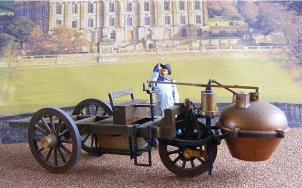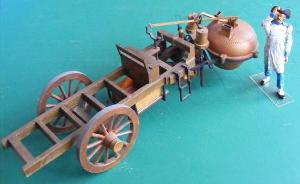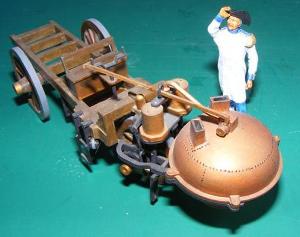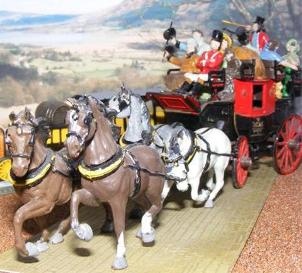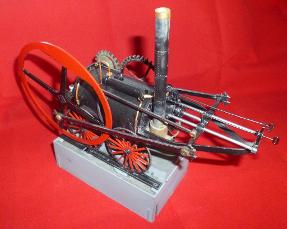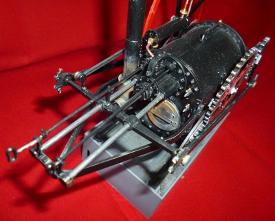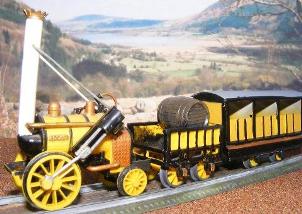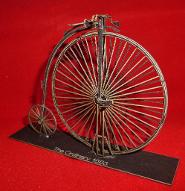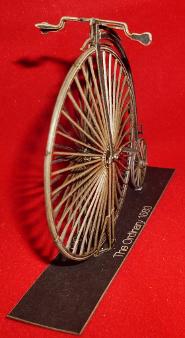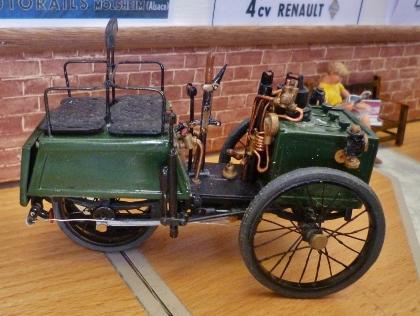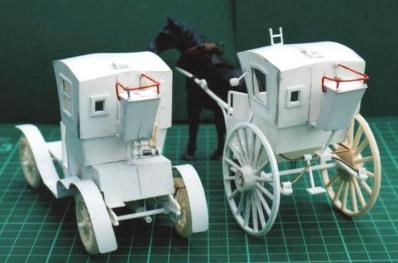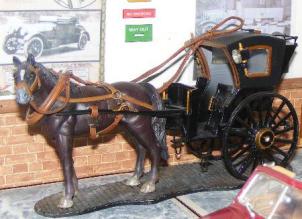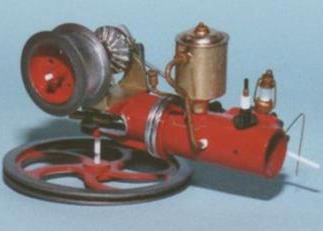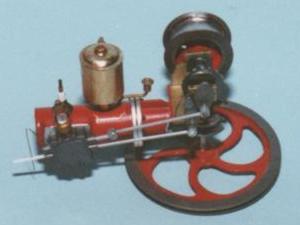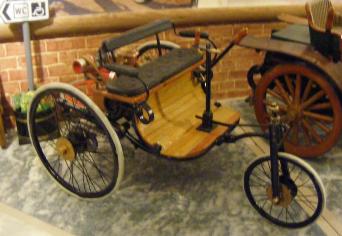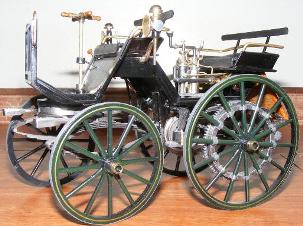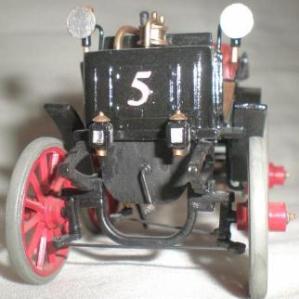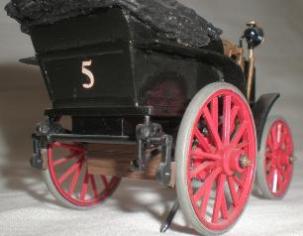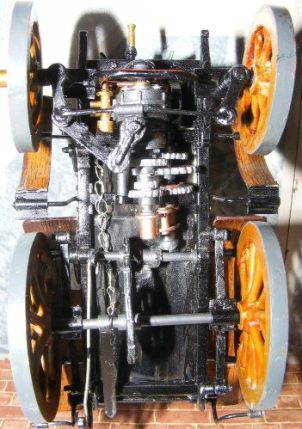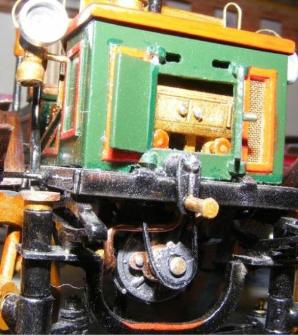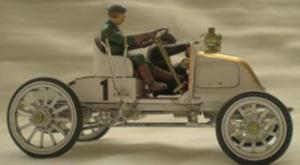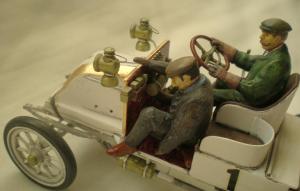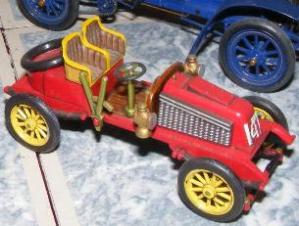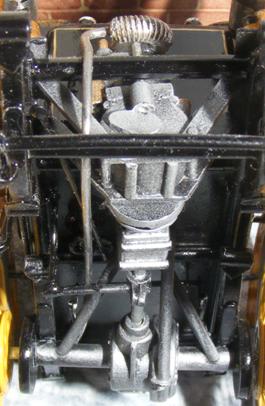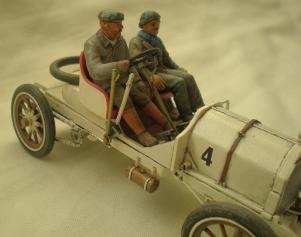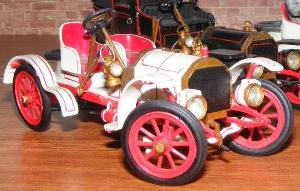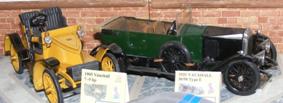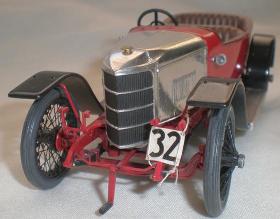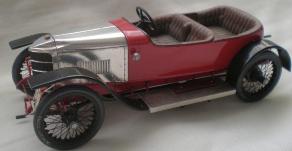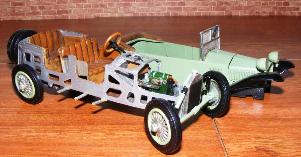The history of automotive transport
The ancestry of automotive transport goes back as far as the 18th Century, well much further than that really but there's little point in reinventing the wheel, so to speak.
Relive the early days of transport and the steps that led to the motor car becoming a viable mode of transport. Everything has to start somewhere and even something as obvious as the steering wheel had to be invented.
1769 Cognot “Fardier a vapeur”.
1/32nd scale Le Teuf Teuf kit
In 1769 Nicholas Joseph Cugnot tried to meet the French Government’s desire for an Artillery Tractor and presented them with a 3-Wheel “fardier a vapeur” weighing almost 5 tons. The machine consisted of 2 parallel vertical bronze cylinders with a- displacement of 62 litres, in which the steam was utilised. The furnace, boiler, and piston engine were all mounted on 3-wooden wheels with iron tyres. The Boiler and furnace were mounted in front of, and over, the front wheel severely limiting vision as well as the steering. It could carry 4 tons at 2 ¼ mph.
A prerequisite of a steam engine is water, but this vehicle had no water tank! hence a travelling duration of only 15 minutes.
The vehicle was demonstrated to high-ranking officers and officials - and promptly crashed. Poor Cugnot therefore has the unenviable distinction of being involved in the first road vehicle accident and of being the first driver taken to Court and fined for careless driving.
1800 Standard pattern mail coach.
Life-Like kit in HO scale.
This standard pattern mail coach built at Millbank, London, in 1827 remained in service until 1842.
Transport in the 17&1800’s was generally by coach. Stage-coaches existed in the 17century, but many vehicles described as ‘coaches’ would have been covered wagons carrying passengers and goods.
Our impression of stagecoach travel from Christmas cards & paintings is very romantic. The reality is much more sobering with several hundred deaths occurring each year through accidents. The Main causes were Hyperthermia, (‘outsiders’ found frozen to death), overturning due to axle/ wheel breakages. Over locking, and, with no brakes, downhill runs depended on the horses to control the speed.
Few people travelled far from home as journeys by coach were considered to be marginally more hazardous than a sea voyage, but fractionally more comfortable.
Steam Power
Steam engines had been around for a while by 1800, usually fixed in position to pump water from mines. Eventually the way to turn the up/down motion into rotational motion was utilised for lifting and hauling. This then evolved into horizontal rotational motion too and all the technology for trying out steam transport had arrived.
Many people made a steam bus or coach for use on the roads. They were not always safe, or effective, but the use of steam for propelling vehicles went on into the 20th century before the internal combustion engine became established. More importantly steam coach operators had to contend with devious tactics from railway backers which even stretched to them lobbying Parliament and getting bills passed that made the cost of running any road going steam service implausible. In truth the biggest problem was building an engine small enough to propel itself and having a chassis strong enough but light enough to make that a reality.
But science was tackling the world of metals, compounds and production methods that would soon have a vehicle srong enough and light enough for a man to propel himself on. Cycling technology would be of great help to the early vehicle manufacturers even if traditional wood applications would remain around for some time.
1803 Coalbrookdale locomotive.
1/32nd scale Airfix kit
The first locomotive to run on rails was the Trevithick steam engine he built for the mine at Coalbrookdale in Shropshire. One of the main achievements was to prove that smooth wheels on smooth rails would have enough friction to provide traction.
Whatever the shortcomings of the recreations, or the kit, the fact remains that the locomotive itself was a landmark vehicle.
1829 George Stephenson’s Rocket.
Loco & tender from the Airfix HO scale kit, the coach is scratch built.
Designed and built in 1829 by Stephenson & Co., Newcastle upon Tyne, proved engines could be used for passenger transport and the railway building boom began.
You can see steam and electric powered vehicles in Hall 1.
1833 William Hancock's "Enterprise".
1/24th scale scratch built model.
In 1833 Hancock's steam omnibus, the "Enterprise" (built for the London and Paddington Steam Carriage Company) began a regular service between London Wall and Paddington via Islington. It was the first regular steam carriage service, and was the first mechanically propelled vehicle specially designed for bus work to be operated.
Metallurgy and science
1883 "Ordinary" bicycle.
1/24th scale Aerobase kit
Bicycles had been developing for the past few hundred years but like automotive transport they were hampered due to lack of technology. Any substance strong enough to withstand the weight of a person and the punishment of the roads was too heavy to move easily.
In the 1800s advances in metallurgy and design produced lightweight hollow tube frames strong enough for a man to ride and propel. Add to that the tensioned spoke wheel and strong light weight wheels furthered the cause of individual mobility.
All this technology would have a direct bearing on the birth of the motor car.
1886 de Dion, Bouton & Trepardoux steam Quadricycle
1/24th scale scratchbuilt model.
In 1882 a small Parisian engineering workshop run by Georges Bouton and Charles Trépardoux was visited by the young Count de Dion. He had seen their models and scientific toys, including a beautifully made small steam engine and he was anxious to meet the makers.
Count de Dion himself had an engineering interest and he was looking for someone to work with him in building a steam vehicle to vie with the new spirit driven automobiles. The design is four wheeled but with the two driven rear wheels so close together it has the appearance of a tricycle. The vehicle also has pneumatic tyres which is one of the earliest uses of them on a motor car.
A similar vehicle took part in the very first organised automobile competition in 1887, the 2km course ran from Neuilly Bridge to the Bois de Boulogne. Georges Bouton won the event on the de Dion, Bouton & Trépardoux machine.
In the Cities Horsepower still reigned
The new vehicles were still really the playthings of the upper classes, out of reach of the ordinary folk and even when it came to public transport it was a brave entrepreneur who put money into the new automotive transport.
1890 Chapman style "Hansom" cab.
1/24th scale scratch built model
The Hansom cab is a familiar sight but Joseph Aloysius Hansom’s cab of 1833 was unlike the vehicle that made his name a household word. Huge 7’ 6” (2.3m) diameter wheels made the absence of springs relatively unobjectionable!
A better cab was patented by John Chapman but his company was bought out by the owners of the original Hansom cab patent. Chapman’s cabs were in all essentials the ‘hansom’ cabs which survived for the next 70 years. Due to the publicity given to the Hansom patent later cabs were still called by Hansoms name instead of their designer’s name.
Internal combustion
The making of cars combined three existing industries, engine builders, bicycle builders and coach builders, and each had a part to play in the way motor cars developed.
The engines of the day were very crude to our eyes but remember we are talking of a time over 130 years ago. They were developed from steam principles and each step along the way to an independent internal combustion engine had to be discovered.
Chassis frames often bore similarities to bicycle frame thinking and wire wheels were straight from the world of cycling, could this Benz have been a penny farthing in another life?
Coach builders were used for the vehicles body work and many cars at the turn of the 20th century bore more than a passing resemblance to the coaches of the day.
1885 Benz Prototype.
1/24th scale scratch built model
Early car production was a combination of three existing industries – cycle makers ( the tubing and wheels), carriage builders (the body & seats) & engine manufacturers.
Benz himself had experience with bicycles and used similar technology when he created an automobile with wire wheels.
His 4-stroke engine had electric coil ignition, making it the first automobile designed to generate it's own power and not simply be a motorised horse carriage. This is the main reason Benz is regarded as the inventor of the motor car.
The Benz was granted a patent for his design and these documents are considered to be the birth certificate of the motorcar
1886 Daimler prototype.
1/16th scale kit by Revell.
At first glance Daimler’s engine seems to have little in common with Benz’s design. Neither does the chassis. Here we have a very simple horse carriage, less the horse! The idea here is simply to prove the concept as many people thought Daimler’s idea of a horseless carriage was plain madness!
Tiller steering is notably absent but the idea of a steering ‘wheel’ still hasn’t quite dawned either.
The different size of wheel at the front and rear followed on from carriage thinking and took several years to subside.
Daimler’s later design for the Phoenix engine set several bench marks such as:- Four vertical, cylinders in parallel cast in one unit.
- Camshaft operated exhaust valves.
- Spray-nozzle carburettor, allowing for quick and precise adjustment of the fuel-air mixture.
- Improved belt drive system.
The Panhard system
The early days of motoring led to long distance trials. This was to establish the new automobile as a safe, cost effective and efficient mode of transport. The trials became races as the manufacturers competed against one another to finish first and garner headlines in newspapers, hopefully realising sales of their cars.
The early engines used hot tube ignition. Basically a little burner box, such as that visible in the front of the green PL, heated a metal tube which led directly into the cylinder and ignited the fuel within. It worked fairly well, as long as the wind didn’t blow the burner out!
1885 Panhard-Levassor.
1/32nd scale Europe kit conversion
In 1895 Emile Levassor drove this car single-handed for 48 ½ hours to win the 732 mile Paris-Bordeaux race at an average speed 15 mph.
Panhard established the cars layout Front wheel steering, front mounted engine, transmission to driven rear wheels and all the passengers facing forward. This remained the basic design layout for cars for decades.
The first automobiles were steered with a tiller, but in 1894 Alfred Vacheron took part in the Paris-Rouen trial with a Panhard 4hp model to which he had fitted a steering wheel. That is believed to be the first use of the steering wheel.
1891 Panhard & Levassor.
1/24th scale scratch built 1891
Panhard established the cars layout Front wheel steering, front mounted engine, transmission to driven rear wheels and all the passengers facing forward. This remained the basic design layout for cars for decades.
The first automobiles were steered with a tiller, but in 1894 Alfred Vacheron took part in the Paris-Rouen trial with a Panhard 4hp model to which he had fitted a steering wheel. That is believed to be the first use of the steering wheel.
Ingenuity and invention
From the mid 1890s to the mid 1920s the speed of development of motor car technology was breathtaking. Almost every new car had a new invention on it and what was new yesterday was better today, rather like the electronic computer technology race of modern times.
1898 Panhard & Levassor.
1/32nd scale scratchbuilt model
From 1898 all Panhard et Levassor cars were equipped with a steering wheel as standard. Arthur Krebs replaced the tiller with an inclined steering wheel for the Panhard he designed for the Paris-Amsterdam race of 1898.
Within ten years, the steering wheel had completely replaced the tiller.
1902 Renault K-type 'Paris-Vienna' winner.
1/43rd scale kit.
Renault frères were the pioneers of shaft transmission as opposed to the more fashionable chain drive.
From very early in their production of cars they preferred this method and worked hard to perfect it. After a few problems they proved it was far more reliable than chain or belt drives.
1902 Renault 'A' type.
1/24th scale scratchbuilt model
The brothers raced the cars themselves until Louis withdrew from racing after his brother, Marcel, was killed in the 1903 Paris - Madrid race, but the company returned to racing to win the first ever Grand Prix in 1906.
1907 Lanchester.
1/32nd scale Airfix kit and conversion.
Frederick William Lanchester’s first car produced in 1895 was remarkable in that it was not a copy of a foreign model, nor an adaptation of a horse drawn carriage, but a brilliant original design.
Later Lanchester inventions for cars include: rack & pinion steering, turbo charging, power steering, 4-wheel drive and even the humble accelerator pedal.
Specification.
4-cyl. 2460cc engine with horizontal valves closed by leaf springs.
Disc brakes.
Wick carburettor. - no jets.
Flywheel Magneto.
Self adj’ Multi-plate clutch in oil bath.
Fully automatic lubrication.
Transmission by 3 speed by Epicyclic gears to worm drive in back axle. (Both features years ahead of their time.)
Max. speed 50 mph.
Tiller Steering.
Lanchester also designed petrol~electric hybrid cars and coined the use of the word 'streamlined'.
1910 Lanchester double Landaulette.
1/32nd scale Airfix kit conversion
1903-04 Mercedes sports cars.
Airfix 1/32nd scale kit conversions
Mercedes grew out of Daimlers racing ambition, or lack of it, when Emile Jellinek, a wealthy diplomat and motoring enthusiast, encouraged them to the build a high performance car.
Wilhelm Maybach was put in charge of project. His developments led to the 1904 car which is considered the first real sports competition car.
Amongst MBs innovations for road and race cars were, 4-cyl. 35hp 6 Lt engine, mechanically operated inlet valves, low tension magneto ignition, transmission brake & internal expanding drum brakes, transmission by 4-spd. ‘box with gate gear change, helical steel spring, pneumatic tyres, steering through worm and gear system, steel channel chassis extending beyond radiator and the first honeycomb radiator with integral water tank.
Vauxhall and Laurence Pomeroy
1/24th scale scratch built 1905 Vauxhall
1/32nd scale Airfix Prince Henry conversion
1/24th scale SouthEastern Finecast kit
Vauxhall’s ‘Prince Henry’ was one of the first sports cars to be catalogued by a British manufacturer. Development began in 1908 when L. H. Pomeroy convinced Vauxhall directors he could redesign the 3ltr engine from 23 to 40 hp with no increase in size. His study of gas flow and valve timing proved revolutionary, not only in the crank shaft speed meaning.
Later the 30/98 of 1920 also benefited from this engine technology.
“Power output is finally dependant upon weight of air efficiently burnt per minute, and this in the end is fixed absolutely by the breathing power of the valve gear. In detail the gas flow will depend on the area of the valves, the lift, and the time during which they are open.”
L. H. Pomeroy.
1922 Lancia Lambda.
1/32nd ILCA kit from Italy
Lancia are one of Italy’s oldest car manufacturers having started in 1906.
Bold and innovative the company gained a reputation for its outstanding cars, such as this 1922 Lambda, Lancia had patented a design for a car without a traditional chassis, inspired by a ship's hull. It also had a V4 2120cc engine.
Later the Lambda was improved with front wheel brakes and a rear axle differential.
The car was capable of nearly 70 mph. and 12,530 built in 9 Series between 1922-1931.
Sizaire-Naudin and de Cauville both had independent front suspension systems on their cars by 1905 but Lancia also created a new, and far superior, design for that too and he used it on the Lambda.
1923 Voisin C6 "Laboratoire".
1/24th scale scratchbuilt model
Voisin worked on the design of the C6 with Andre Lefebvre to give the world it's first monocoque chassis in 1923.
Drawing upon his aviation experience he set two precedents, using aircraft technology and one piece body/chassis construction, which were decades ahead of their time.
Unitary construction did become common practice in the 1950s but true monocoque designs really found their place in motor racing as late as 1962.
So there you have it. By 1925 almost all the important development of the car was done. Although we haven’t mentioned dual spark plugs and different cylinder head shapes or even four valves per cylinder they had all been tried, and, forced induction by super chargers was on the horizon.
Everything since has been a development, or refinement, of some one else’s earlier idea. Not until the advent of computer control of engines would anything truly different make it's way onto the motorcar.
